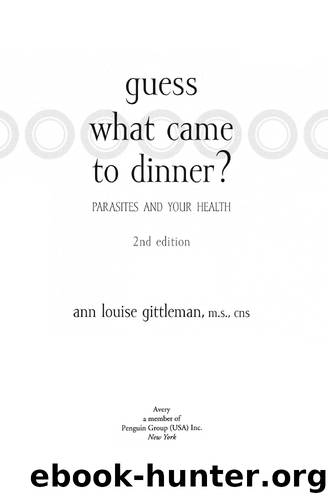Guess What Came to Dinner? by Ann Louise Gittleman Ph.D. CNS

Author:Ann Louise Gittleman, Ph.D., CNS [Gittleman, Ann Louise]
Language: eng
Format: epub
ISBN: 9781101662496
Publisher: Penguin Publishing Group
Published: 2001-07-09T00:00:00+00:00
But two groundbreaking findings are giving diagnosis of parasite infection a promising turn. The first exciting work is being done at Stanford University School of Medicine. Scientists there have been using computers not only to study the DNA of several parasitic species but to genetically fingerprint them. Their intent is to more easily define the type of infection an individual has, in an effort to better outline the mode of treatment required. Complementing that technology, scientists at Berkley are planning to manufacture what they call a âlab on a chipâ that will contain these genetic fingerprints. Once achieved, physicians everywhere will have the data readily available for use on their office PCs.
The second important discovery is a stool antigen test. Iâve already shared with you how tricky it can be to detect the presence of Entamoeba histolytica, giardia, or cryptosporidium infections. Once these parasites stop shedding (after seven weeks in the case of E. histolytica), they can no longer be detected accurately. In fact, chronic cases sometimes produce a false negative stool exam. This new testing method is considered to be one of the most accurate methods available in determining pathogenic Entamoeba histolytica, giardia, and cryptosporidium infections. Using an immunofluorescent staining technique, this breakthrough method can detect the protein shell fragments of the actual parasite, normally not visible microscopically. It is, however, not an especially pleasant method of testing. So unless youâre really determined, I would first suggest having a salivary GI test to determine the presence of Entamoeba histolytica. The salivary test (listed under the following Clinical Test section) may be particularly helpful during that non-shedding stage mentioned earlier.
Even with all these new findings, common sense would dictate that we use a variety of methods to confirm the suspected parasitic invaders present in the body.
Download
This site does not store any files on its server. We only index and link to content provided by other sites. Please contact the content providers to delete copyright contents if any and email us, we'll remove relevant links or contents immediately.
| Antioxidants & Phytochemicals | Caffeine |
| Cancer Prevention | Fiber |
| Food Additives | Food Allergies |
| Genetically Engineered Food | Macrobiotics |
| Vitamins & Supplements |
Nutrition for Sport, Exercise, and Health by Spano Marie & Kruskall Laura & Thomas D. Travis(3245)
Nutrition for Sport, Exercise, and Health by Marie Spano & Laura Kruskall & D. Travis Thomas(3242)
The Sprouting Book by Ann Wigmore(3058)
Flavor Flours by Alice Medrich(2347)
Memory Rescue by Daniel G. Amen(1971)
Superfood Smoothie Bowls: Delicious, Satisfying, Protein-Packed Blends that Boost Energy and Burn Fat by Chace Daniella(1918)
The Bad Food Bible by Aaron Carroll(1895)
Dirty Genes by Ben Lynch(1863)
The Main Street Vegan Academy Cookbook by Victoria Moran(1704)
Genius Foods by Max Lugavere(1704)
The Poisoner's Handbook by Deborah Blum(1666)
Good Calories, Bad Calories by Gary Taubes(1662)
The I Quit Sugar Cookbook by Sarah Wilson(1631)
Core Performance Essentials by Mark Verstegen(1625)
Memory Rescue: Supercharge Your Brain, Reverse Memory Loss, and Remember What Matters Most by Amen Dr. Daniel G(1576)
Big Girls Do It Stronger by Jasinda Wilder(1572)
Android App Development by Franceschi Hervé J.;(1500)
Sugar Crush by Dr. Richard Jacoby(1468)
Dr. Colbert's Keto Zone Diet by Don Colbert(1324)
